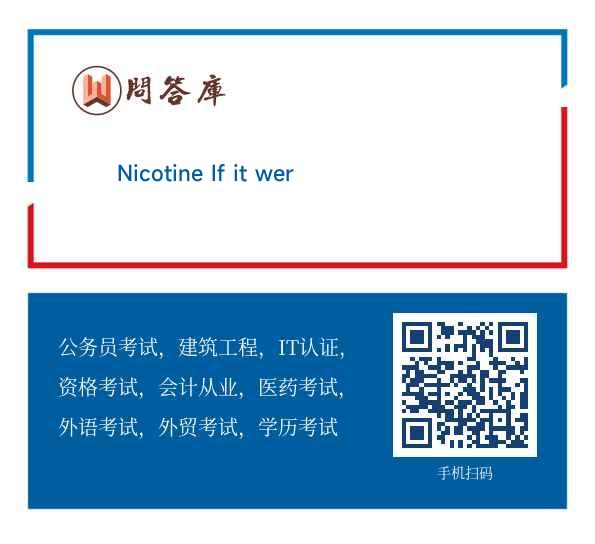Nicotine If it weren't for nicotine people wo
问题详情
Nicotine
If it weren"t for nicotine, people wouldn"t smoke tobacco. Why? Because of the more than 4000 chemicals in tobacco smoke, nicotine is the primary one that acts on the brain, altering people"s moods, appetites and alertness in ways they find pleasant and beneficial. Unfortunately, as it is widely known, nicotine has a dark side: it is highly addictive. Once smokers become hooked on it, they must get their fix of it regularly, sometimes several dozen times a day. Cigarette smoke contains 43 known carcinogens, which means that long-term smoking can amount to a death sentence. In the US alone, 420,000 Americans die every year from tobacco-related illnesses.
Breaking nicotine addiction is not easy. Each year, nearly 35 million people make a concerted effort to quit smoking. Sadly, less than 7 percent succeed in abstaining for more than a year; most start smoking again within
days.So what is nicotine and how does it insinuate itself into the smoker"s brain and very being?
The nicotine found in tobacco is a potent drug and smokers, and even some scientists, say it offers certain benefits. One is to enhance performance. One study found that non smokers given doses of nicotine typed about 5 percent faster than they did without it. To greater or lesser degrees, users also say nicotine helps them to maintain concentration, reduce anxiety, relieve pain, and even dampen their appetites (thus helping in weight control). Unfortunately, nicotine can also produce deleterious effects be yond addiction. At high doses, as are achieved from tobacco products, it can cause high blood pressure, distress in the respiratory and gastrointestinal systems and an increase in susceptibility to seizures and hypothermia.
First isolated as a compound in 1828, in its pure form. nicotine is a-clear liquid that turns brown when burned and smells like tobacco when exposed to air. It is found in several species of plants, including tobacco and, perhaps surprisingly, in tomatoes, potatoes, and eggplant (though in extremely low quantities that are pharmacologically insignificant for humans).
As simple as it looks, the cigarette is highly engineered nicotine delivery device. For instance, when tobacco researchers found that much of the nicotine in a cigarette wasn"t released when burned but rather remained chemically bound within the tobacco leaf, they began adding substances such as ammonia to cigarette tobacco to release more nicotine. Ammonia helps keep nicotine in its basic form, which is more readily vaporised by the intense heat of the burning cigarette than the acidic form. Most cigarettes for sale in tile US today contain 10 milligrams or more of nicotine. By inhaling smoke from a lighted cigarette, the average smoker takes 1 or 2 milligrams of vaporised nicotine per cigarette. Today we know that only a miniscule amount of nicotine is needed to fuel addiction. Research shows that manufacturers would have to cut nicotine levels in a typical cigarette by 95% to forestall its power to addict. When a smoker puffs on a lighted cigarette, smoke, including vaporised nicotine, is drawn into the mouth. The skin and lining of the mouth immediately absorb some nicotine, but the remainder flows straight down into the lungs, where it easily diffuses into the blood vessels lining the lung walls. The blood vessels carry the nicotine to the heart, which then pumps it directly to the brain. While most of the effects a smoker seeks occur in the brain, the heart takes a hit as well. Studies have shown that a smoker"s first cigarette of the day can increase his or her heart rate by 10 to 20 beats a minute. Scientists have found that a smoked substance reaches the brain more quickly than one swallowed, snorted (such as cocaine powder) or even injected. Indeed, a nicotine molecule inhaled in smoke will reach the brain within 10 seconds. The nicotine travels through blood vessels, which branch out
A.Y
B.N
C.NG
